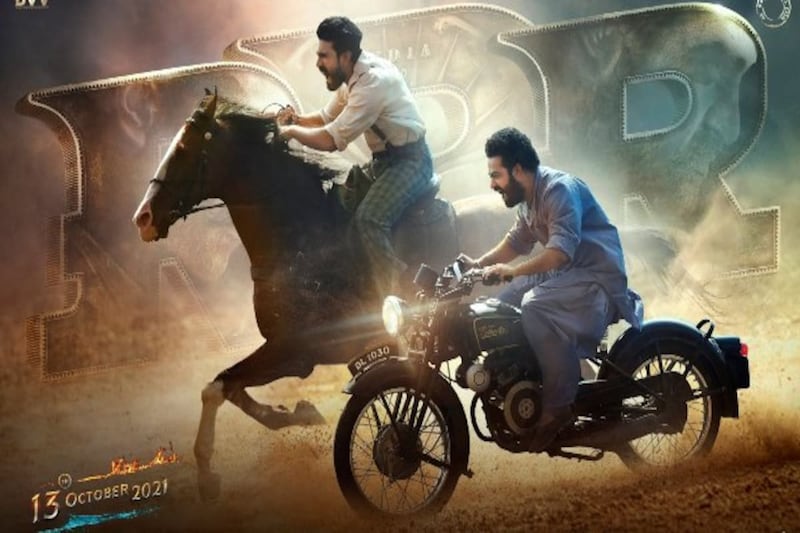The Indian cinema industry has, in terms of features produced, long been the world’s busiest. Films from that nation play well here. This week in Dublin’s Cineworld you could catch Jass Grewal’s Baajre Da Sitta and Shaji Kailas’s Kaduva. But engagement outside the Indian communities remains fitful. The media (mea culpa) pays little attention. Only more adventurous cinemagoers from other heritages queue up for the musical epics, sweeping romances and knee-shaking action films.
This year, one film has done more than any predecessor to break down those prejudices. SS Rajamouli’s RRR is a sensation. An anti-colonial extravaganza that lands with the energy of a meteor strike, the picture presents a wildly fictionalised study of two real-life Indian revolutionaries from the 1920s. NT Rama Rao Jr plays tribal leader Komaram Bheem. Ram Charan is the much-celebrated Alluri Sitarama Raju. Like so many Indian films, RRR (the title stands for Rise, Roar, Revolt in these territories) mixes elaborate song and dance numbers with combat and light comedy.
We begin with the inhumanely evil colonial governor and his even more dastardly wife abducting a sweet child from her parents in Adilabad. A recurring motif is set early on when the villain explains it is not worth wasting an expensive bullet on an Indian and has a resister beaten to death instead. Researches fail to confirm if Rajamouli is enjoying an ironic aside by casting Irish actors as these two English monsters. Ray Stevenson, from Lisburn, is volcanic as Governor Scott Buxton. Alison Doody, the Dubliner best known for Indiana Jones and the Last Crusade, returns triumphantly as a psychopath for the ages. Her best moment comes late when, as one of the heroes is being publicly lashed, she offers his tormentor a bigger whip, more elaborately decorated with filthy spikes. Bheem and Raju come together. They are antagonists. Then they are not. Along the way, somebody throws a fully grown, digitally generated leopard at an attacking soldier.

The film was released in March to ecstatic reviews from those non-specialist critics who sought it out (even if a few wrongly identified this Telugu production as “Bollywood”). Reviews correctly praised a dynamic coherence you rarely find in the messy clatter of the modern American action film. An early musical sequence operates on a fantastic scale that makes Baz Luhrmann seem like Ken Loach. Many talked up the uniqueness of the Indian sensibility, but the director himself has been keen to cite a recent American influence. “Inglorious Basterds is one of the biggest inspirations when it comes to my films, specifically RRR,” he said. That makes sense. Both Quentin Tarantino’s war flick and Rajamouli’s anti-Raj extravaganza streeeetch the truth around violent wish fulfilment.
From holiday homes to rural depopulation, the numbers game is not stacking up in Clare
Look inside: Light-filled redbrick with ‘iceberg’ extension in Portobello for €1.4m
Patrick Freyne: Returning home from Chad, I feel there’s a glitch in western empathy
How can investors manage in the world according to Trump?
At any rate, the film is now a genuine hit and a subject of endless online chatter. It is the fourth-highest-grossing Indian film ever. It is the most watched Indian film on Netflix. The recent arrival of “controversy” confirms RRR’s mainstream, worldwide triumph. Knowing how weirdly overseas writers often misrepresent Irish political arguments, we should not say too much about internal objections to RRR, but it is worth noting Ritesh Babu’s comments in an article this month for Vox. Babu greatly enjoyed the film, but worried that it was among those “movies that stoke the flames of nationalism in the current India and its troubling political climate”. He further argues that “it is very much a fantasy of the upper-caste Hindu gaze, and all those willing to go along with its hegemony.” This may or may not be so.
Arguments in a recent piece by Prof Robert Tombs for the Spectator (former editor, B Johnson) are less difficult to engage with. The author also touches on worries about pandering to “reactionary and violent Hindu nationalism,” but he begins with inaccuracies about the Indian Civil Service and the “nasty” portrayal of the governor and his wife. “If similar films were made slandering other nations, they would be regarded as crudely racist,” he continues. But there is also a lovely English lady in the film. The caricatures are surely aimed at demonising the colonial mentality rather than the British nation itself.
SS Rajamouli will surely know to take the criticism as backhanded compliment. “Netflix should be ashamed for promoting it,” the Spectator thunders. Few are the Indian films to receive such attention in the world’s oldest existing weekly magazine. The attention will intensify if RRR manages to become its country’s sole submission for the best international feature Oscar.

Anne Thompson, veteran Hollywood insider, now writing for IndieWire, has it down as a front-runner for that prize, but, for all the fuss and acclaim, it cannot be guaranteed the Indian jury will give RRR the nod. It was only last year that Shoojit Sircar’s Sardar Udham, another story of Indian resistance, was turned down amid arguments from one jury member that the film “projects hatred towards British”.
Either way, RRR will feed off the attention. One of the year’s unstoppable cultural phenomena.
RRR is currently streaming on Netflix.














